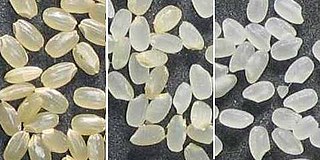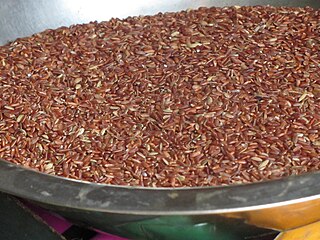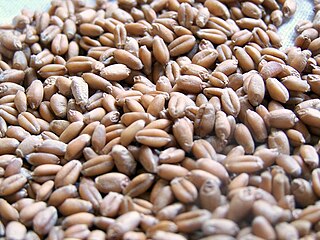
Rice is a cereal grain, and in its domesticated form is the staple food for over half of the world's human population, particularly in Asia and Africa, due to the vast amount of soil that is able to grow rice. Rice is the seed of the grass species Oryza sativa or, much less commonly, O. glaberrima. Asian rice was domesticated in China some 13,500 to 8,200 years ago, while African rice was domesticated in Africa some 3,000 years ago. Rice has become commonplace in many cultures worldwide; in 2021, 787 million tons were produced, placing it fourth after sugarcane, maize, and wheat. Only some 8% of rice is traded internationally. China, India, and Indonesia are the largest consumers of rice. A substantial amount of the rice produced in developing nations is lost after harvest through factors such as poor transport and storage. Rice yields can be reduced by pests including insects, rodents, and birds, as well as by weeds, and by diseases such as rice blast. Traditional rice polycultures such as rice-duck farming, and modern integrated pest management seek to control damage from pests in a sustainable way.

Bran, also known as miller's bran, is the hard layers of cereal grain surrounding the endosperm. It consists of the combined aleurone and pericarp. Corn (maize) bran also includes the pedicel. Along with the germ, it is an integral part of whole grains, and is often produced as a byproduct of milling in the production of refined grains.

White rice is milled rice that has had its husk, bran, and germ removed. This alters the flavor, texture and appearance of the rice and helps prevent spoilage, extend its storage life, and makes it easier to digest. After milling (hulling), the rice is polished, resulting in a seed with a bright, white, shiny appearance.

Parboiled rice, also called converted rice, easy-cook rice, sella rice, and miniket is rice that has been partially boiled in the husk. The three basic steps of parboiling are soaking, steaming and drying. These steps make the rice easier to process by hand, while also boosting its nutritional profile, changing its texture, and making it more resistant to weevils. The treatment is practiced in many other parts of the world.

Rice hulls or husks are the hard protecting coverings of grains of rice. In addition to protecting rice during the growing season, rice hulls can be put to use as building material, fertilizer, insulation material, or fuel. Rice hulls are part of the chaff of the rice.

Black rice, also known as purple rice or forbidden rice, is a range of rice types of the species Oryza sativa, some of which are glutinous rice.

Japanese rice refers to a number of short-grain cultivars of Japonica rice including ordinary rice (uruchimai) and glutinous rice (mochigome).

Rolled oats are a type of lightly processed whole-grain food. They are made from oat groats that have been dehusked and steamed, before being rolled into flat flakes under heavy rollers and then stabilized by being lightly toasted.

Jasmine rice is a long-grain variety of fragrant rice. Its fragrance, reminiscent of pandan and popcorn, results from the rice plant's natural production of aroma compounds, of which 2-acetyl-1-pyrroline is the most salient. A rapid loss of aromatic intensity leads many Southeast Asians and connoisseurs to prefer each year's freshly harvested "new crop" of jasmine rice. Jasmine rice is a variety of Oryza sativa.

Jollof, or jollofrice, is a rice dish from West Africa. The dish is typically made with long-grain rice, tomatoes, chilies, onions, spices, and sometimes other vegetables and/or meat in a single pot, although its ingredients and preparation methods vary across different regions. The dish's origins are traced to Senegal.

Red rice is a variety of rice that is colored red by its anthocyanin content. It is usually eaten unpolished or partially polished, and has a red bran layer, rather than the more common pale brown. Red rice has a nutty flavor. It has the highest nutritional value among rices eaten with the bran intact.

A rice mill is a food-processing facility where paddy is processed to rice to be sold in the market.

Refined grains have been significantly modified from their natural composition, in contrast to whole grains. The modification process generally involves the mechanical removal of bran and germ, either through grinding or selective sifting.

A wheat berry, or wheatberry, is a whole wheat kernel, composed of the bran, germ, and endosperm, without the husk. Botanically, it is a type of fruit called a caryopsis. Wheat berries have a tan to reddish-brown color and are available as either a hard or soft processed grain They are often added to salads or baked into bread to add a chewy texture. If wheat berries are milled, whole-wheat flour is produced. Wheatberries are similar to barley, with a somewhat nuttier taste.

Red Cargo rice is a type of non-glutinous long grain rice that is similar to brown rice, in that it is unpolished. The color of the bran is red, purple, or maroon. The husks of the rice grains are removed during the milling process, retaining all the nutrients, vitamins, and minerals intact in the bran layer and in the germ.
In the cuisine of Sikkim, in northeastern India, rice is a staple food, and fermented foods traditionally constitute a significant portion of the cuisine. Indian cuisine is popular, as Sikkim is the only state of India with an ethnic Indian Gorkha majority. Many restaurants in Sikkim serve various types of Nepalese cuisine, such as the Limbu, Newa and Thakali cuisines. Tibetan cuisine has also influenced Sikkimese cuisine. The combination of various cuisines has resulted in one specific cuisine.

Oryza glaberrima, commonly known as African rice, is one of the two domesticated rice species. It was first domesticated and grown in West Africa around 3,000 years ago. In agriculture, it has largely been replaced by higher-yielding Asian rice, and the number of varieties grown is declining. It still persists, making up an estimated 20% of rice grown in West Africa. It is now rarely sold in West African markets, having been replaced by Asian strains.
In agriculture, grain quality depends on the use of the grain. In ethanol production, the chemical composition of grain such as starch content is important, in food and feed manufacturing, properties such as protein, oil and sugar are significant, in the milling industry, soundness is the most important factor to consider when it comes to the quality of grain. For grain farmers, high germination percentage and seed dormancy are the main features to consider. For consumers, properties such as color and flavor are most important.
Rice is commonly consumed as food around the world. It occurs in long-, medium-, and short-grained types. It is the staple food of over half the world's population.




















